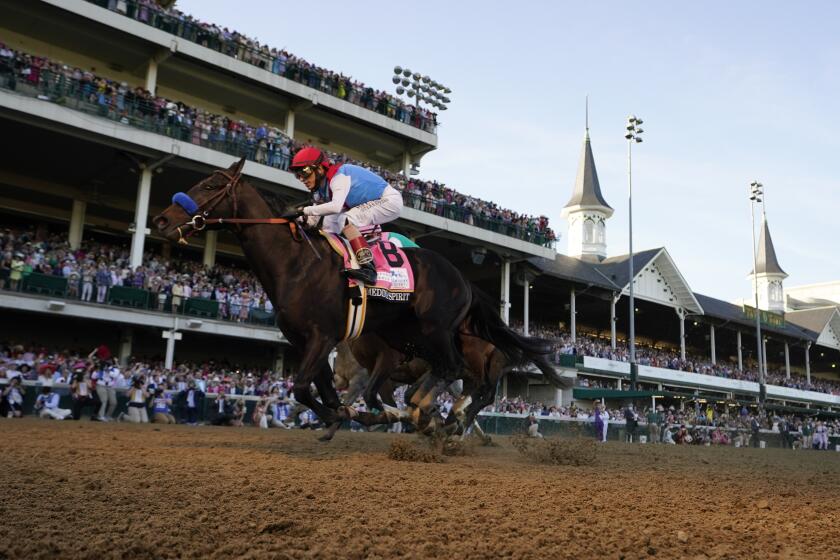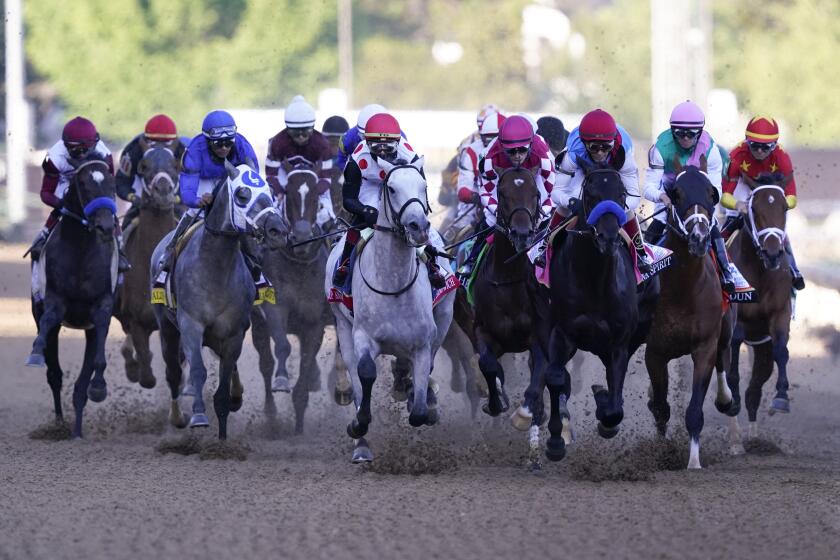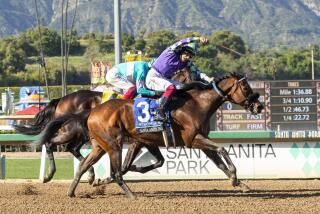Does the drug that could strip Medina Spirit of a Kentucky Derby win enhance performance?

- Share via
Medina Spirit gained instant recognition when he won the Kentucky Derby on the first Saturday in May. Now, as horse racing is struggling to establish a positive image nationally, that fame has turned to infamy.
The 3-year-old colt is on the verge of being the second horse ever disqualified from the Kentucky Derby for a medication violation in 147 years. But we may not know the outcome for a long time as the process wends its way from testing laboratories to stewards’ hearings to the courts.
Medina Spirit and stablemate Concert Tour left Churchill Downs by van early Monday morning and arrived in Baltimore in the afternoon. The Maryland Jockey Club has not said that Medina Spirit will be eligible to run in the Preakness, but with the draw Tuesday afternoon, a decision has to be made soon.
Trainer Bob Baffert is taking both his and his horse’s case to the public. On Sunday, after he made the announcement of the positive test for betamethasone, Baffert made the rounds, appearing on NBC’s “Nightly News” as well as a horse racing show on a small Los Angeles radio station.
On Monday, he was on Fox News saying he was temporarily banned from running at Churchill Downs because of “cancel culture.”
“With all the noise going on, we live in a different world now,” Baffert said. “This America is different, and it was like a cancel culture kind of thing, so they are reviewing it.”
Even former President Donald Trump has weighed in, calling Medina Spirit a “junky [sic].”
Answering key questions about Kentucky Derby winner Medina Spirit and trainer Bob Baffert after the horse tested positive for an anti-inflammatory drug.
So, as the rhetoric has increased and the pro- and anti-Baffert factions have fortified their beliefs, the question not being asked is what kind of edge the presence of betamethasone would give Medina Spirit in the Kentucky Derby.
Or, put another way, is Medina Spirit really a junkie?
The answer seems to be that the drug has little performance-enhancing value.
Betamethasone is classified as a corticosteroid, a type of anti-inflammatory that can be used on humans, horses or other creatures. It can be administered topically or by intra-articular injection. On horses, it’s mostly injected into joints to ease inflammation and, if the inflammation is reduced, any associated pain subsides. But it is not considered a painkiller.
“You can’t equate it with the classic forms of performance enhancers such as amphetamines or blood doping,” said Dr. Mary Scollay, executive director and chief operating officer at the Racing Medication and Testing Consortium. “The reason we regulate it is for the protection of the horses, jockeys and everyone around them.”
Scollay explained that inflammation can often cause heat to radiate from the area. If the horse is treated with betamethasone, there is no heat and it is more difficult for a veterinarian to determine if a horse is sound or has other problems.
“You don’t want to increase the chance of injury by not being able to detect a problem,” Scollay said. “It helps the trainer, groom, everyone who comes in contact with the horse. You don’t want medication to fool them into poor decision-making.”
It’s true that a horse will run better if it is not in pain, so in that respect, it does help performance. But it’s also why in most states, including California and Kentucky, all intra-articular injections must cease 14 days prior to a horse running in a race. This way, the prerace veterinary exam can be more accurate and, hopefully, catch any potential problems.
There is also the issue about how much betamethasone was in Medina Spirit’s system on race day. The horse had 21 picograms in his blood or serum. A picogram is a trillionth of a gram and is measured in milliliters. Scollay says there are about 50,000 ml of blood in a horse.
“Think about grains of sand on a beach,” said Scollay, who was the equine medical director for the Kentucky Horse Racing Commission for 11 years. “But that’s a measurement of weight and doesn’t give potency. Think about a pound of celery and a pound of Godiva chocolates. They both weigh the same but are polar opposite in what they can do.”
Still, the testing is pretty solid and reliable and the chances of getting caught are extremely high.
Oh yeah, we’ve got stewards’ rulings too.
“It would make no sense, in my opinion, to push the envelope and think no one is going to see it,” Scollay said. “It’s one of the things that is always tested for.”
For a horse to be disqualified, according to regulations, a second test — or a “split sample” — must also be positive.
Both Scollay and Dr. Rick Arthur, equine medical director of the California Horse Racing Board, say it’s extremely rare for a split sample to come back with different results. The results of this split sample will likely take two to four weeks.
Arthur said the amount in each sample can be different based on the testing laboratory, so it would mostly involve threshold drugs. Betamethasone is no longer a threshold drug because there is zero tolerance for any in a horse’s system. It was 10 picograms until August when it was lowered to zero.
The two longtime regulatory veterinarians also say that the overwhelming number of drug and medication positives are the result of mistakes by those administering the drug, not subterfuge.
“You can treat the wrong horse, have the wrong medication in the feed or thought the horse was entered last week,” Scollay said.
There’s no doubt that all the attention will be on one particular horse entered in Saturday’s Preakness Stakes. And if Medina Spirit wins the race and is one victory from a Triple Crown, horse racing will be stuck in a situation it never saw coming and will have a difficult time resolving.
More to Read
Go beyond the scoreboard
Get the latest on L.A.'s teams in the daily Sports Report newsletter.
You may occasionally receive promotional content from the Los Angeles Times.













